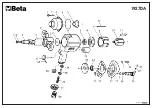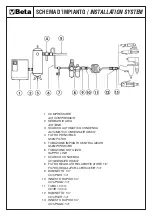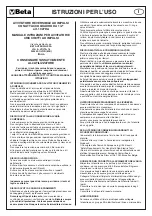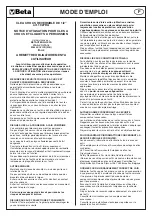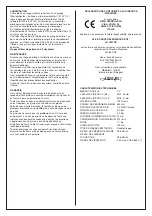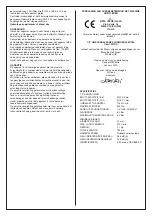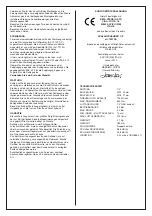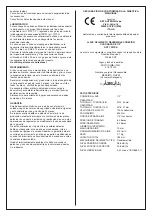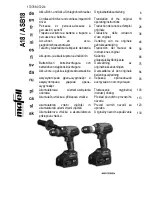
Beta
INSTRUCTIONS
GB
1/2” REVERSIBLE IMPACT WRENCH
item 1927DA
INSTRUCTION MANUAL FOR IMPACT
WRENCHES AND RATCHETS
Tool distributed by:
BETA UTENSILI SPA
VIA A. VOLTA, 18
20050 SOVICO (MB)
ITALY
TO BE ABSOLUTELY DELIVERED TO THE
USER
To reduce the risk of any, damage to people, before using
or repairing the tool, doing any maintenance jobs or
replacing any accessories,
READ ALL THE SECTIONS OF THE INSTRUCTION MANUAL
CAREFULLY.
SAFETY ISTRUCTIONS FOR IMPACT WRENCHES
It is our aim to supply air tools which allow you to work
efficiently and SAFELY.
It is however understood that YOU are the most important
‘safety device’ for any tool, as taking meticulous care is the best
way of preventing injury.
Although we cannot enumerate all types of risks here, we tried
to lay stress on some of the most significant ones.
Let us remind you that this tool must be used only by skilled
workers and that the machine must never be forced; do not
overload the tool.
RISKS DUE TO CONNECTION TO COMPRESSED AIR
Compressed air may harm people severely.
Do not direct air towards you or any other people.
The air coming out of the hoses may harm people severely;
periodically check whether the hoses and/or fittings are loose
and/or have been damaged.
Whipping hoses may cause severe damage.
Before handling the tool, close the main plant, release residual
pressure and disconnect the tool only when it is not working.
Pressure must not exceed 6.2 bar, as measured at the air inlet
while the tool is working, or the value shown on the tool plate.
RISKS OF VARIOUS KINDS
Stay at a safety distance from the rotating parts of the tool.
Do not wear any accessory round your neck, such as chains or
necklaces. Do not wear any bracelets or loose clothes.
Avoid contact of accessories and tools with your hair.
Avoid contact with any accessories in motion, while the tool is
being used or after it has been used.
Always wear work gloves to reduce the risk of cutting and
burning yourself.
RISKS DUE TO SPLINTERS AND FRAGMENTS
Warning: small splinters and fragments may also harm your
eyes and result in blindness.
Always wear eye protection while using the tool, doing any
maintenance jobs and replacing any accessories or spare
parts. This measure must also be taken by anyone who
works nearby.
Use only impact sockets in good condition, fixing them with an
O-ring and a locking pin where the spindle makes this possible.
Do not use any hand sockets.
No joints and extensions should be used, as they affect the
efficiency of the wrench and result in an increased risk of
breakdowns. Therefore, we recommend using long impact
sockets only when needed.
Do not use the tool improperly, as it might work too quickly,
thus causing the accessories to be ejected.
RISKS RELATED TO WORKING CONDITIONS
Mind too long hoses left at the work station; stumbling and
falling is likely to result in severe injury.
High noise levels may result in permanent loss of hearing;
wear ear protection, as recommended by the employer
and/or the regulations
.
Stay in a safe, well-balanced position.
Repetitive movements and awkward positions combined with
vibrations may cause your hands and arms to be harmed;
special precautions should be taken.
Do not breathe dust and waste; partially protect yourself
with a filtering mask
.
Both the workers and the maintainers must be physically fit for
the size, weight and power of this tool.
This tool was not designed to be used in areas exposed to the
risk of explosion and is not so insulated as to come into contact
with power sources.
OTHER SAFETY REQUIREMENTS
This tool and its parts and accessories must not be modified
and/or tampered with.
The building material of this tool may be subject to wear.
Working with compressed air tools may result in high
vibrations; therefore, take any precautions needed.
Prevent your hands from being trapped between the tool and
any object.
FOR FURTHER INFORMATION ABOUT SAFETY REFER TO
THE FOLLOWING:
The documents, information and instructions supplied with this
tool;
The employer, trade associations and/or trade unions;
The EEC Council and/or local authorities
“Safety Requirements for Hand Held Non-Electric Tools”,
available at: European Committee for Standardization, Rue de
Stassart 36, 1050 Brussels, Belgium.
REQUIREMENTS FOR PROPER AIR CONNECTION
Feed the tool with clean air, free from water or condensate, at a
pressure of 6.0 bar, as measured at the air inlet, while the tool
is working.
An excessively high pressure results in a shorter life for the
mechanical parts and may cause people to be severely
harmed.
Connect the tool to the feeding plant, using accessories of the
same size as that shown in the enclosed drawing.
Do not fix any quick couplers directly into the air inlet.
Consult the instructions to connect the accessories properly.
Consult the specifications in this manual.
LUBRICATION
For optimal use, connect the tool to a filter-lubricator unit
provided with an air-oil microfog mixer (items 1919F 1/2”), set
at two drops per minute, pouring special oil ISO 32 (item
1919L) in. The above-mentioned accessories will translate into
a high-performing tool and wear-resistant mechanical parts.
If the line is not supplied with any lubricator, pour oil ISO 32 or
SAE #10 into the tool at least once a day.
Check on a monthly basis whether the clutch or the hammer
device is properly lubricated. Use – if need be – SAE #30 for
the clutches and bearing grease on the hammer devices.
Do not use kerosene or diesel oil.
MAINTENANCE
If the tool should not start back after it has not been used for
quite long, disconnect it and turn the square drive by hand,
thus preventing adhesion.
Disassemble and inspect the power unit and tool assembling
every 3 months if the wrench is used every day, replacing any
worn parts.
We recommend using the enclosed exploded view as a manual
to disassemble and assemble the tool as well as to identify any


